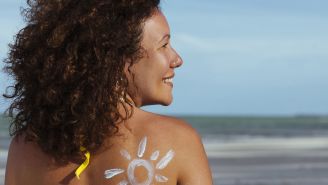Updated on June 3, 2022.
You know that wearing sunscreen is one of the best ways to protect yourself from skin cancer, especially if you’re heading out for a long day in the sun. But with all the different products available, it’s hard to know what type of sunscreen to buy.
We spoke with Holly McCoppin, MD, a dermatologist at Overland Park Regional Medical Center in Kansas, to set the record straight on sunscreen and SPF.
What’s the difference between UVA and UVB rays?
Dr. McCoppin: Both UVA (ultraviolet A) and UVB (ultraviolet B) rays damage the skin. UVA rays are the chief cause of wrinkles, sagging, and other signs of aging. UVB rays are the main cause of sunburn. Both cause skin cancer.
What does SPF stand for, and how is that number determined?
Dr. McCoppin: SPF—or sun protection factor—is a measure of a sunscreen's ability to prevent UVB rays from damaging the skin. Let’s say it takes 20 minutes for your unprotected skin to start turning red. Using an SPF 30 sunscreen theoretically prevents reddening/sunburn 30 times longer.
What is broad-spectrum sunscreen?
Dr. McCoppin: "Broad spectrum" means the sunscreen offers effective protection against both UVA and UVB rays. For maximum protection, choose a broad-spectrum sunscreen.
Does a higher SPF provide better protection? What SPF sunscreen number is best?
Dr. McCoppin: SPF 15 filters out approximately 93 percent of all incoming UVB rays. SPF 30 keeps out 97 percent and SPF 50 keeps out 98 percent. No sunscreen can block all UV rays, and a sunscreen with an SPF above 50 provides negligible increased protection. I recommend my patients use SPF 30 or greater on all their exposed skin every day.
So how does sunscreen protect your skin from sun exposure?
Dr. McCoppin: Sunscreens combine several ingredients that help prevent the sun's ultraviolet (UV) radiation from reaching the skin. There are chemical sunscreens (with ingredients like avobenzone, benzophenone, salicylates, cinnamates, etc.) that absorb the UV rays as they hit your skin, and there are physical sunscreens with titanium dioxide and zinc oxide that deflect, or block, the UV rays from the skin.
Is one type of sunscreen safer or better than the other?
Dr. McCoppin: Some patients have an allergy to certain chemical sunscreens, so they use the physical blockers. Despite recent claims about sunscreen safety, sunscreen products are safe and effective when used as directed.
How much sunscreen should I use?
Dr. McCoppin: The average adult needs to apply 1 ounce—about a shot glass full—to their skin 30 minutes before sun exposure. Sunscreens lose effectiveness over time, so it’s important to reapply the same amount every two hours, and after swimming, toweling off, or heavy sweating. During a long day outdoors, one person should use around one half to one quarter of an 8-ounce bottle.
Do cosmetics that provide SPF protection offer enough protection or should regular sunscreen be worn as well?
Dr. McCoppin: Many after-shave lotions, moisturizers, and make-up products have a sunscreen already in them. If the SPF is 15 or greater, this is sufficient for everyday activities with a few minutes here and there in the sun. However, if you work outside, or spend a lot of time outdoors, you need a water-resistant sunscreen with SPF 30 or greater.
Do waterproof sunscreens really work?
Dr. McCoppin: The terms “water-resistant” and “sweat-resistant” indicate whether the sunscreen remains effective for 40 minutes or 80 minutes, when you’re swimming or sweating. Sunscreens that have a water resistance rating of 80 might say they are “very water-resistant,” but since no sunscreen is fully “waterproof” or “sweatproof,” the FDA prohibits these terms.
More sunscreen strategies
Remember these smart tips whenever you apply sunscreen:
- Don’t forget your ears, neck, the top of your head, and the tops of your feet if you’re wearing shoes that expose them to the sun.
- Don't forget your lips, either. Use a lip balm with an SPF of at least 30.
- Use sunscreen even on cloudy days if you’re going to be outdoors.
- If you have sensitive skin, you may want to opt for physical sunscreens with zinc oxide or titanium dioxide.
- Throw out sunscreens that are past their expiration date. They typically last about three years.







